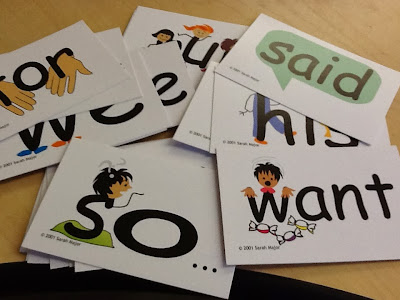Last week I had an out of town PD and an early morning staff meeting. One thing thing was said in both situations that struck me. I can't put quotes around it because I never, ever remember things exactly as they are said. But, basically, I was reminded that we are constantly in the revision process.
And we are.
Last year I posted a post about my
small group routine. Through some great PD on
Jan Richardson's The Next Step in Guided Reading and observations I have made of our Orton Gillingham teacher, more revisions have been made to my routine.
My new routine looks like this:
(based on Jan Richardson's template with my added components)
This looks like a lot and it is but I will tell you the routine is quick, efficient and when I complete the lesson by saying, "How was your effort today?" my kids reply, "What!! We are done?"
So...let's break this down. This is a two day plan. I fill out two of these a week and then my fifth day is for assessments.
Step One: Phonological Awareness or Familiar Reading
My first two to three minutes of group are spent on either Phonological Awareness or Familiar Reading. It really depends on the time or year and what my group needs. At the beginning of the year, I do a lot of
phonological awareness activities. This year I read a lot of rhyming texts and we used them to break apart sounds, count words, or change sounds.
But as the year continues, we move on to familiar reading. Right now we are reading nursery rhymes and variations of nursery rhymes. They are quick, simple, and fun to read. I compiled the ones that I use here:
As the year progresses even further, we may use short passages or short books as our quick familiar reading at the beginning of group.
Step Two: Phonics
-Review vowels and consonants (takes less than a minute):
I use flashcards for this. It is very quick. We say the sound, then the letter name. If my group does not need this review, I skip this component.
-NWF: nonsense word fluency (takes 1 minute):
It helps me to determine if students are blending sounds accurately. If this comes easily to my group, we look for nonsense words within larger words. I want them to see the value in blending these sounds quickly and effortlessly. I use these sheets for this:
Written review of sounds (about 1 minute):
At this time I want to review vowel patterns or chunks that we have been focusing on. To do this, I may review some flashcards, but then I ask them to write the pattern. For instance, I will say, "Write the chunk that says /sh/." As they write, I expect them to say the sound. I typically choose about 3 patterns. If there is an error, I correct the individual and they write the pattern three times.
After some trial and error, I have found that it works best for me to
have them write these sounds on the back of their phonics sheet (photo
below).
Introduction to new sound (about 1 minute):
This is when I introduce the new phonics pattern that I would like them to focus on. After my introduction, they write this pattern three times on their paper as they say the sounds to themselves.
Highlight Sounds or Sentences (about 5 minutes):
This is where we put the phonics skills together. I use this same sheet all week. But basically, the students are either highlighting the pattern we are focusing on or they are reading the sentences where the skill is embedded. ( I outlined my procedures
HERE.)
Step Three: Sight Words
Dictate Words (about 2 minutes):
I ask the students to write three of the sight words that we have been working on. They do this on a dry erase board. At this time, students spell the word as they write. If there are any mistakes, I assist the child and they rewrite the word three times.
Flashcards (about 30 seconds):
Then I use my Snapword cards to review previous or introduce new sight words. These cards have pictures to help my visual learners but they have the plain old word on the back of them.
Phrases (about 30 seconds):
I just want to ensure that they can read these words in context. So we read through a few short phrases together.
Step Four: Reading the Text
We read the same text for two days. This is what the layout looks like for those days.
This is the meat of my guided reading time and it takes about 10-15 minutes (or it is my goal to spend that amount time on the book). My introduction is quick and includes our examination of some key vocabulary words. Then the students dig in to the text and whisper read independently. At times we chorally read together to build fluency and confidence. The second day includes rereading but I also like to include some type of comprehension activity.
Step Five: Introduce New Sight Word
This last step is very quick. It takes less than a minute. I introduce one new sight word that will become part of their dictation practice that I shared with you above. We "play" with this word by mixing up letter tiles and fixing the word or I write the word with missing letters and they correct me.
And our groups always end by discussing our effort (mine included).
I know...it is a lot. It is intense. But I have really enjoyed the changes and feel like I am hitting their needs.
Plus....I am always up for more revisions :)






































